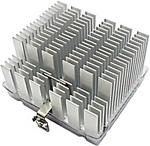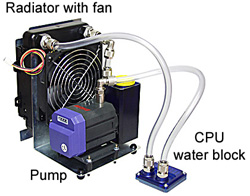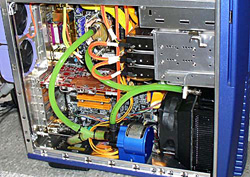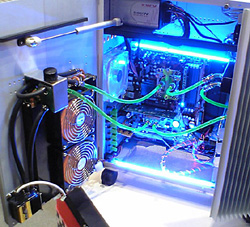| This article has been published [fromdate] |
| [readtime] |
Chips and disk drives get hot, and we need to transfer heat away from them to stop their temperature rising too high.
The heat flows from the device (which is at a high temperature) to the nearby air (which is at a lower temperature). However, as the surrounding air warms up, the rate of flow decreases.
Heat Sink
The rate of heat transfer depends upon the size of the area between the device and the nearby air.
A heat sink attaches to a device and increases its surface area with fins made of metal (which conducts heat very well). Heat sinks are a form of passive cooling.

Thermal compound
The point between the device and the heat sink will never be perfectly smooth. This will reduce the area and limits the amount of heat that may be transferred to the heat sink.
Thermal compound (also called thermal paste or heat sink compound) goes between the device and the heat sink, filling microscopic pores in the area. The paste conducts heat well, ensuring that the heat sink dissipates as much heat as possible.
The paste dries out over time so it is advisable when removing a heat sink to clean off all old paste with isopropyl alcohol (IPA) and apply new paste when re-mounting.
Fans
By moving new (cool) air into the vicinity of devices (and moving old (warmer) air away) we can maintain a temperature difference, ensuring a high heat transfer rate.
To do this we use a fan. Because it requires power this is called active cooling.

A large fan spinning at low speed will give the same air flow as a small fan at high speed. Air flow is measured in cubic metres or feet per second.
Fans produce noise (measured in dB — a lower dB rating is quieter). Smaller fans tend to produce more noise because they need to spin faster.
Cheaper fans use lubricated rings called sleeve bearings. The lubricant on these can dry up (especially at high temperatures), leading to failure. They also perform poorly if the fan is not horizontal.
Better fans use ball bearings. These can work at a higher range of temperatures and are more durable. They also generate less noise.
Fluid bearings and magnetic bearings are very quiet indeed.
Liquid Cooling
Water transfers heat away more efficiently than air, so some PCs now use it as their primary coolant.

Cold water flows from the radiator to the CPU water block (which is attached to the CPU with thermal compound); the warmed water then flows through the pump back to the radiator. The fan blows air across the radiator's fins, cooling the water by transferring the accumulated heat to the air and out of the case.
Further water blocks can be connected in the loop, absorbing heat from hard drives, the north bridge and the graphics card.

What if it leaks?
In a tower case the mains power supply is usually at the top of the case, meaning that there is a low probability that water would mix with live mains electricity.
However, any leaks could possibly short-circuit components and cause damage. If a leak occurs the equipment should be powered off immediately and left to dry out.
A well-maintained system should be free of leaks.

SOURCE | LINK (talktoanit.com) | LANGUAGE | ENGLISH |

